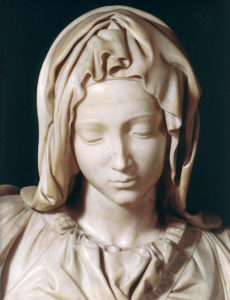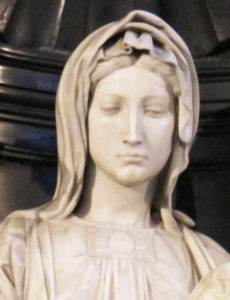Michelangelo Buonarroti Sonnet XVII
Here is my translation of Michelangelo’s sonnet number seventeen, followed by the original text, then by another translation from more than 100 years ago, for comparison.
Here is me, reading my own translation:
XVII
How can this be, my lady, what we see,
as we observe, the living image in
hard mountain stone has longer life than I,
its maker, whom the years turn back to dust?
Effect must bend and cede before the cause
here, where art does triumph over nature;
I strive at sculpture, and so this I know,
that she does overcome both time and death.
And thus to both of us I give long life
in either manner, painted or in stone,
in which our faces seem to be each others’.
After us a thousand years will pass, and
all will see your beauty, and my sadness,
and never foolish was my love for you.
Translation © 2016 Christopher DiMatteo. All rights reserved.
Sonetto XVII di Michelangelo Buonarroti (originale)
Com’ esser, donna, può quell ch’ alcun vede
Per lunga sperienza, che più dura
L’ immagin viva in pietra alpestra e dura,
Che ‘l suo fattor, ch egli anni in cener riede?
La causa all’ effetto inclina e cede,
Onde dall’ arte è vinta la natura.
Io ‘l so, che ‘l provo in la bella scultura ;
Ch’ all’ opra il tempo e morte non tien fede.
Dunque posso ambo noi dar lunga vita
In qual sie modo, o di colore o sasso,
Di noi sembrando l’ uno e l’ altro volto :
Sì che mill’ anni dopo la partita
Quanto e voi bella fusti, e quant’ il lasso
Si veggia, e com’ amarvi io non fui stolto.
For Comparison: A 1904 Translation
Here is J.A. Symonds’ 1904 translation, for reference and for reflection on the business of translating this kind of work. Symonds was a well-known art historian and his books are still in university and public libraries and also now online.
This is the original’s rhyme scheme: ABBA, ABBA, CDE, CDE
-ede -ura -ura -ede
-ede -ura -ura -ede
-ita -asso -olto
-ita -asso -olto
In order to reproduce the rhymes, even partially as he does, Symonds has to stray from the text in some places, writing words and images that are not in the original. I have put these parts in underlined bold. I think Symonds’ translations of the Michelangelo sonnets aren’t bad but they are not my style. I think that by altering the text to create rhymes in English, he has placed himself between the author and the reader in I way that I prefer to avoid.
XVII as translated by J.A. Symonds, published in 1904:
How can that be, lady, which all men learn
By long experience? Shapes that seem alive,
Wrought in hard mountain marble, will survive
Their maker, whom the years return to dust!
Thus to effect cause yields. Art hath her turn,
And triumphs over Nature. I, who strive
With Sculpture, know this well; her wonders live
In spite of time and death, those tyrants stern.
So I can give long life to both of us
In either way, by colour or by stone,
Making the semblance of thy face and mine.
Centuries hence when both are buried, thus
Thy beauty and my sadness shall be shown,
And men shall say, ‘For her ‘twas wise to pine.’


